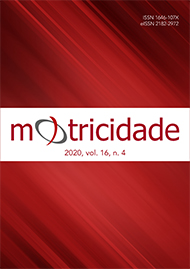Beach Volleyball: Temporal Analysis and Endocrine Responses of National Athletes
DOI:
https://doi.org/10.6063/motricidade.20377Abstract
The aim of this study was to characterize temporal aspects and to verify the acute effect of a beach volleyball game on testosterone, cortisol and T:C ratio in young athletes. Participants were 16 male athletes (age= 17 ± 2,44 years, height= 1,84 ± 0,06 m, body mass 76,23 ± 9,54 kg, BMI 22,35 ± 1,92, number of training sessions per week 4 ± 1,20 days). Athletes made a match with official rules which was filmed for analysis. Saliva was used to measure testosterone and cortisol levels and testosterone/cortisol ratio (T:C ratio) was calculated. Hormonal analyzes were done in duplicate using ELISA method and comparisons between beginning of the match, end of the first set and end of the match using Anova one-way of repeated measures. Total match duration was 30 min and 49s (± 0.01s), with rallies of 6s (± 01s) and time between rallies of 20s (± 0.02s). Cortisol showed a linear tendency increasing over time and T:C ratio showed a quadratic tendency reducing at the end of first set and reestablishing at the end of the game. It is noteworthy that a beach volleyball match lasting approximately 30 minutes promotes enough stimulus to generate impact on endocrine markers.
Keywords: Athletes, Biological markers, Biomarkers, Athletic performance.
Downloads
Published
Issue
Section
License
The authors of submitted manuscripts must transfer the full copyright to Journal Motricidade / Sílabas Didáticas Editions. Granting copyright permission allows the publication and dissemination of the article in printed or electronic formats, and copyrights start at the moment the manuscript is accepted for publication. It also allows Journal Motricidade to use and commercialise the article in terms of licensing, lending or selling its content to indexation/abstracts databases and other entities.
According to the terms of the Creative Commons licence, authors may reproduce a reasonable number of copies for personal or professional purposes, but without any economic gain. SHERPA/RoMEO allows authors to post a final digital copy (post-printing version) of the article on their websites or on their institutions' scientific repository.


